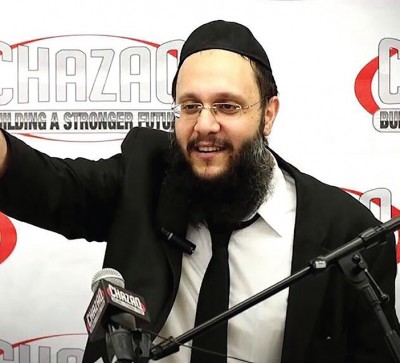
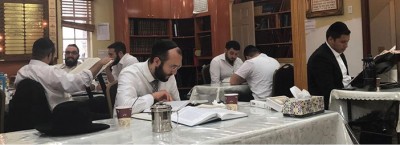
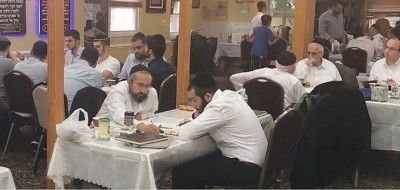
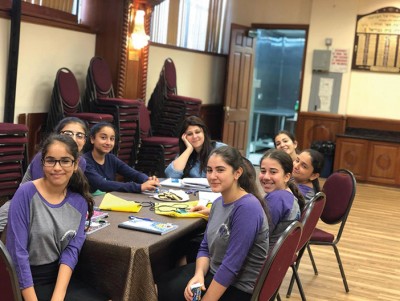

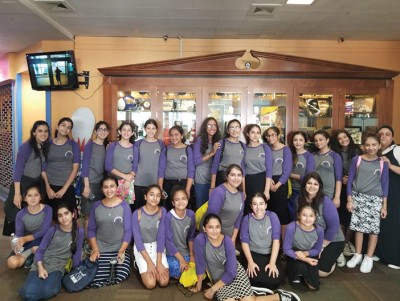
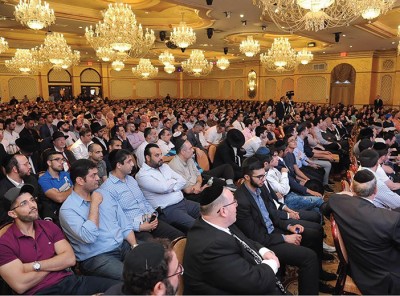
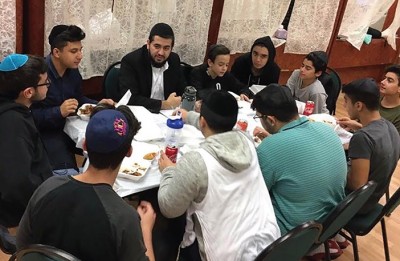
CHAZAQ is a well-known organization that is based in Queens, New York, offering various programs and services that have inspired tens of thousands since their inception in 2006.
As we close upon another year in the Jewish calendar, I had a chance to speak with CHAZAQ’s director Rabbi Ilan Meirov to discuss their accomplishments and challenges of the past year.
Aside for his involvement with CHAZAQ, Rabbi Meirov (RM) is also one of the youth minyan Rabbi’s in the Beth Gavriel Center in Forest Hills, is authoring his fourth book and is involved with numerous community projects. Although the interview was rather short, it was very informative and will open our eyes in understanding CHAZAQ’s overall vision and goals.
DB: I know CHAZAQ had a very humble beginning and over the years it has grown tremendously. When you started over 12 years ago, did you ever expect things to be this “big”?
RM: The truth is, when getting involved with any form of work with the Klal (public) one can’t focus on anything other than putting in 100 percent effort. Are we happy with our accomplishments? Yes. Are we satisfied with it? Absolutely not. We realize that we aren’t even close to reaching our potential.
DB: CHAZAQ has so many different divisions; from men, to women, to children, to teens, to public school students, even senior citizens. How do you juggle so many things at once? And is having too many programs not detracting one from another?
RM: You ask a very good question. Lema’aseh, success in such a great fashion is never due to the work of one or two individuals. It is due to a group effort and a lot of siyata dishmaya (divine assistance). Every division and program CHAZAQ offers has its own directors who oversee its many details. They are all given a solid team to work with in order to accomplish their set of goals. In addition to that, we baruch hashem have a very dedicated group of board members that truly believe in our cause and we have several prominent Rabbis that guide us through all the difficult decisions we come across.
And so, if for example, you see several CHAZAQ afterschool programs happening simultaneously in 4 locations, you should know there is a dedicated team behind this operation. Or if you sometimes see 4 or 5 CHAZAQ lectures on the same day in different cities, you should know each distinct location has amazing people running the show.
And so, to answer your question, if we were not structured properly then yes one program would definitely detract from the other. But baruch hashem we have a very strong group of men and women that work tirelessly to build a better future for our community and oversee every aspect of each program diligently.
DB: I thought the CHAZAQ motto was “Building a STRONGER future”?
RM: Yes (smile). I apologize, to build a stronger future for the community.
DB: I recently read that CHAZAQ transferred over 470 public school students to Yeshiva over the past two years alone. How is this possible? What is the formula for this success and how long does it take to convert a case from public school to yeshiva?
RM: Once again, it all comes down to team work and a lot of Siyata Dishmaya. A small intro is needed to understand the complexity of this operation.
CHAZAQ’s public school outreach is broken up to 3 parts. We have a division for children, a division for teenagers and a division dedicated for yeshiva placement.
The children’s division includes the Shaping Lives Sunday School and Yaldeinu Afterschool programs. These programs help jewish public school children develop a basic foundation in Judaism. From learning the alef-bet, to reading and learning about the parsha and holidays, CHAZAQ educates hundreds of children that are lacking a Jewish education and we truly give them an experience that will impact them for life.
The CHAZAQ teens division, known as JWave, is an operation in of itself. Thousands of Jewish teens are unfortunately not only losing their jewish identity but are also involved in drugs and crime. So firstly we seek to keep the teens off the streets and bring them into a safe environment. In addition, our highly talented rebbeim and teachers work diligently to instill these youth with a love and thirst for their Jewish heritage. Just in Forest Hills High school alone, there are well over 1,000 Jewish youth mostly of Bukharian descent but many Georgians, Persians and Ashkenazim as well. They are all amazing boys and girls though the set of challenges they face are probably greater than the challenges we have faced in any other time in history. And so at CHAZAQ we look to give them the tools necessary to deal with these challenges and help guide them to a life of Torah and mitzvoth, each in his or her own pace.
As for the yeshiva placement division, known as PSTY (Public school to Yeshiva), that is an operation that is truly remarkable. We now have a team of about 10 men and women, who have all the contact information of all the hundreds of students of CHAZAQ’s children and teens afterschool programs, along with the contacts of hundreds of other families that have been to our programs or been referred to us. Our team sit diligently and try to assist all parents of these public school students make the best decision in terms of their child’s future.
Most of the time the process can be extremely difficult as there are many obstacles in the way (i.e. one parent objects to a yeshiva education or the yeshiva they want didn’t accept their child) and once you overcome one obstacle, you hit another. You should know, that generally with teenagers its much tougher as the fact that they are older they therefore have a “say” as to what school they go to (after all, public schools can finish as early as 1 or 2pm while yeshiva goes beyond 4 or 5 pm so naturally they don’t want to switch). Thus, with teens, our afterschool programs are a lifeline. Without it, they would be totally disconnected. Whereas with children, the conversion rate to yeshiva is much greater.
As for the average time to convert a case from public school to yeshiva, it can be close to half a year. And on many occasions, it takes well over a year. But with due diligence we baruch Hashem see tremendous results. Like you said, we have hit over 470 in the last two years and as far as the last update I received, we are at over 110 in the last two plus months alone.
We have had some Rabbonim came to our office to check out our operations up close and they were truly mesmerized by how organized each and every file is with each and every case.
DB: Truly remarkable. How many yeshivas do you work with and is it ok if I ask which yeshiva has thus far received the most students?
RM: We work with dozens of yeshivas throughout the United States, though you would need to ask the PSTY division for the exact number. Baruch hashem we have a great relationship with most of them and they all try to accommodate the students to the best of their capabilities. One Yeshiva that has drawn a lot of interest from parents over the past 2 years has been Be’er Hagolah. I believe they have thus far accepted the most students from us during the last two years, nearing about 80 new students. There are obviously many other wonderful yeshivas that have accepted dozens of students as well. And we appreciate everyone’s assistance and cooperation.
DB: When you look back at the past year, with all your great work with hundreds of public school students and of course where CHAZAQ had the The Big Event with 2000 people, what do you think is the “highlight” of the year?
RM: Well, CHAZAQ organizes hundreds of shiurim and lectures throughout the year with each lecture targeting a specific audience. Some lectures focus on the frum (religious) members of the community and others focus on the unaffiliated. Most are in English but some are in Hebrew or Russian, so on and so forth. So the Big CHAZAQ event is special in that it attracts all the different members of klal yisrael from all backgrounds and religious affiliation and brings them together under one roof. Someway somehow they are all inspired together by Rabbis who have the gift of speaking to people of different “levels” at once. But I wouldn’t call that the highlight of the year as ultimately that’s just one evening.
As for the success with the public school students, that truly is our pride and joy. We are literally changing the lives of hundreds upon hundreds of students in a tremendous fashion. But ultimately, we invest so much time and money into it, that anything less than what we accomplish would be disappointing.
So, if I need to pinpoint one highlight, it would be CHAZAQ’s Beth Midrash and Kollel. I know most people, if not all, would disagree with me on this but we now baruch Hashem have over 10 avreichim learning in our bet midrash and to see 40-60 men (mixture of college age students and working men) learning for several hours every morning is truly heartwarming. So while looking at sheer numbers, it doesn’t compare to the other programs but the way I see it, if you have hundreds upon hundreds being brought back to a life a Torah we need to build leaders to guide them in the very near future. And that’s what our Beth Midrash is doing. We look to build and polish the spiritual leaders of tomorrow. So that’s why seeing this develop over the past year is so significant in my humble opinion.
DB: That is quite a surprise. Any closing remarks for our readers?
RM: Closing remarks? I guess I will use this opportunity to thank everyone from the bottom of my heart for their continued trust and support. Everything we accomplish is thanks to your dedication. It truly is a partnership in every sense of the word and as the Zohar hakadosh says, those who bring hashems children back to a life of Torah, have tremendous rewards awaiting for them.
Furthermore, it says that a blessing of a simple person should not be taken lightly. And so, I would like to wish everyone a year full of bracha and hatzlacha in all their endeavors along with good health and continued growth in Torah. May we all merit a personal geula and ultimately the geula shleima mehera!
By Daniel Bender
CHAZAQ Year In Review: An Interview With Rabbi Ilan Meirov
Typography
- Smaller Small Medium Big Bigger
- Default Helvetica Segoe Georgia Times
- Reading Mode




